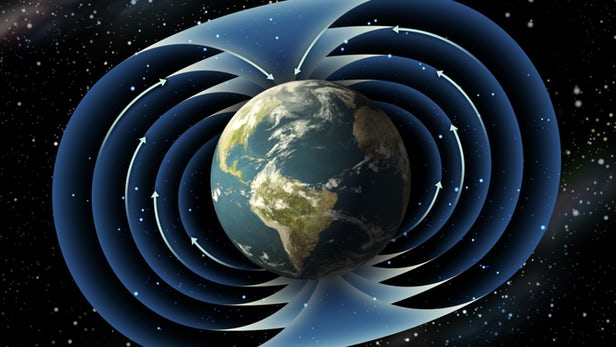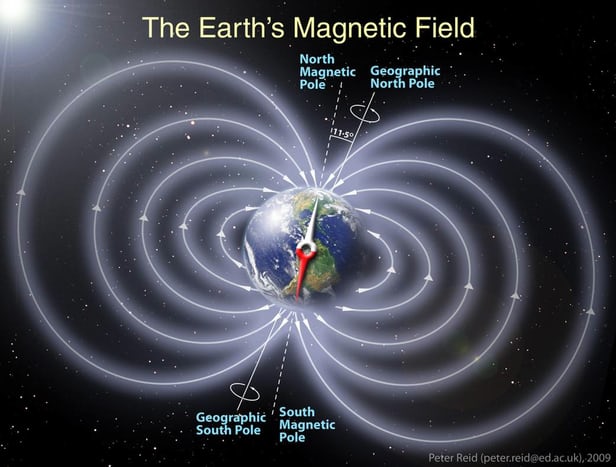Ancient pottery reveal weakening of Earth's magnetic field isn't cause for alarm

Analysis of ancient pottery has revealed fluctuations of the Earth's magnetic field throughout history(Credit: Andreus/Depositphotos)
Ancient pottery reveal weakening of Earth's magnetic field isn't cause for alarm Analysis of ancient pottery has revealed fluctuations of the Earth's magnetic field throughout history(Credit: Andreus/Depositphotos)
|
As if we didn't have enough to worry about, one doomsday scenario making the rounds is that the Earth's magnetic field will one day reverse and cause mass extinctions of the sort not seen since the dinosaurs bit the dust. But a team of researchers from Tel Aviv University, Hebrew University of Jerusalem, and the University of California San Diego have reached a different conclusion. By studying ancient pottery handles, the scientists have determined that the Earth's magnetic field isn't in imminent danger of reversing, but has fluctuated over the millennia with the field spiking in the 8th century BCE.
One of the Earth's peculiar qualities is its powerful magnetic field. This not only allows people to use compasses for navigation, but it also protects the planet from a number of threats from outer space. Thanks to the field, deadly cosmic rays are trapped in the Van Allen belts high above the Earth, where they do no harm to Earthlings and produce the auroras. In addition, the field deflects the solar winds, which have stripped away the atmospheres of other planets, such as Mars and Mercury.
The problem is that, even after centuries of study, very little is known for certain about the dynamics of the magnetic field and how it's generated beyond that it has something to do with the movements of Earth's molten iron core acts like an immense dynamo. One property of the field is that it's not constant. Not only do compasses point to magnetic north rather than true north, but the pole shifts by about 300 mi (483 km) per century and the intensity of the field varies over time. Also, every 200,000 to 300,000 years the poles flip 180 degrees as north becomes south and south becomes north.

The latter is particularly worrying in some circles with speculation that not only could the magnetic field flip at any time, but with catastrophic results. The fear is that the field is weakening and will vanish entirely during the reversal, resulting in the radiation trapped in the Van Allen Belts raining down on the Earth and the solar winds tearing away the upper layers of the atmosphere. The result is feared to be mass extinctions on a scale never seen in human history.
Scientists, including those at NASA, say that the evidence from the geological and fossil records don't support the magnetic apocalypse scenarios. The field has reversed many times since the days of the dinosaurs, but none of these correspond to mass die offs. The space agency says that the main effect of a reversal would be a boom market for compass makers.
The question remains, is the magnetic field in danger of suddenly reversing itself? Led by Dr Erez Ben-Yosef of TAU's Institute of Archaeology, a team of scientists has looked into the matter by turning to a surprising source of information: pottery handles.
Normally, the field of palaeomagnetism, or the study of the history of the magnetic field, relies on geological samples, including cores taken in the vicinity of the Mid-Atlantic Ridge. We don't think of rocks like basalt and granite as being magnetic, but these and other minerals contain iron oxide compounds that act like tiny magnets and align themselves with the magnetic lines of force when they form.
This is because magnetic substances lose their magnetic properties when they heat above a certain temperature called the Curie point. When the molten magma flows out of the underwater volcanoes of the Mid-Atlantic ridge as Europe and North America move away from one another, it cools into solid rock. As it does so, it is influenced by the magnetic field and this lays down a series of bands showing the timeline of the magnetic field's direction and intensity like sequences on a gigantic reel of magnetic tape.
That's fine for geological time scales, but it's of no use for scientists wanting to examine a shorter timeframe encompassing the last few thousand years. For this, the researchers turned to something more manmade and, more importantly, dateable.
In the ancient world, ceramics were as common as plastics are today. They were used extensively for storage and it was a regular practice to stamp pottery and other ceramics with maker's marks, content symbols, and the year of the current monarch's reign. Think of it as an Iron Age bar code and you get the idea. In addition, firing clay in a kiln resets the magnetic field of the pottery the same as melting rock does, so ceramics can give an accurate record of the magnetic field's intensity and when it was measured all in one package.
For the study, the researchers looked at 67 ancient Judean storage jar handles, which bore royal stamps from the 8th to the 2nd century BCE or from the Iron Age through the Hellenic period. By studying the stamps and their typology, they could be dated with accuracy and precision.
These handles were taken to the Paleomagnetic Laboratory of Scripps Institution of Oceanography (SIO), University of California San Diego, where they were examined using paleomagnetic ovens and a superconducting magnetometer, which measured the magnetic fields of the handles with great accuracy. They were then heated in an oven until their fields were erased, before being subjected to a field of known intensity and remeasured. By comparing the two measurements mathematically, the scientists were able to precisely calculate the field at the time of firing.
After comparing the field measurements, the team found that rather than being stable or showing a predictable downward progression leading to a reversal, the Earth's magnetic field has been fluctuating for centuries, with a peak in the 8th century BCE called the "Iron Age Spike" that was the strongest in 100,000 years. Evidence of this spike was first observed by the team in 2009, but they say that the current study both corroborates this and places it in context. The upshot is that the Earth isn't facing a sudden reversal.
According to Ben-Yosef, the new findings have implications for archaeologists by providing a new means of dating to back up Carbon 14 methods.
"Both archaeologists and Earth scientists benefit from this" says Ben-Yosef. "The new data can improve geophysical models – core-mantle interactions, cosmogenic processes and more – as well as provide an excellent, accurate dating reference for archaeological artefacts."
The study was published in PNAS.
Source: